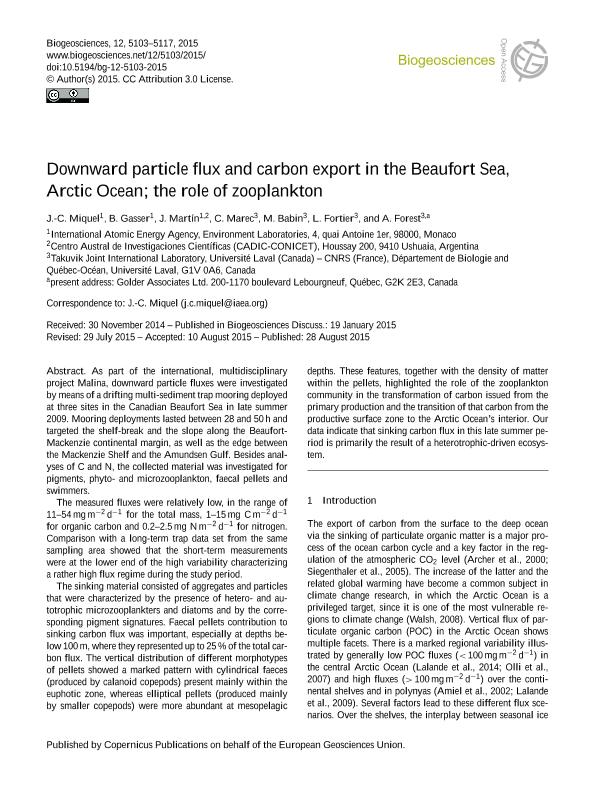Artículo
Downward particle flux and carbon export in the Beaufort Sea, Arctic Ocean; the role of zooplankton
Miquel, J. C.; Gasser, B.; Martín de Nascimento, Jacobo ; Marec, M.; Babin, M.; Fortier, L.; Forest, A.
; Marec, M.; Babin, M.; Fortier, L.; Forest, A.
 ; Marec, M.; Babin, M.; Fortier, L.; Forest, A.
; Marec, M.; Babin, M.; Fortier, L.; Forest, A.
Fecha de publicación:
08/2015
Editorial:
Copernicus Publications
Revista:
Biogeosciences
ISSN:
1726-4170
e-ISSN:
1726-4189
Idioma:
Inglés
Tipo de recurso:
Artículo publicado
Clasificación temática:
Resumen
As part of the international, multidisciplinary project Malina, downward particle fluxes were investigated by means of a drifting multi-sediment trap mooring deployed at three sites in the Canadian Beaufort Sea in late summer 2009. Mooring deployments lasted between 28 and 50 h and targeted the shelf-break and the slope along the Beaufort-Mackenzie continental margin, as well as the edge between the Mackenzie Shelf and the Amundsen Gulf. Besides analyses of C and N, the collected material was investigated for pigments, phyto- and microzooplankton, faecal pellets and swimmers.
The measured fluxes were relatively low, in the range of 11–54 mg m−2 d−1 for the total mass, 1–15 mg C m−2 d−1 for organic carbon and 0.2–2.5 mg N m−2 d−1 for nitrogen. Comparison with a long-term trap data set from the same sampling area showed that the short-term measurements were at the lower end of the high variability characterizing a rather high flux regime during the study period.
The sinking material consisted of aggregates and particles that were characterized by the presence of hetero- and autotrophic microzooplankters and diatoms and by the corresponding pigment signatures. Faecal pellets contribution to sinking carbon flux was important, especially at depths below 100 m, where they represented up to 25 % of the total carbon flux. The vertical distribution of different morphotypes of pellets showed a marked pattern with cylindrical faeces (produced by calanoid copepods) present mainly within the euphotic zone, whereas elliptical pellets (produced mainly by smaller copepods) were more abundant at mesopelagic depths. These features, together with the density of matter within the pellets, highlighted the role of the zooplankton community in the transformation of carbon issued from the primary production and the transition of that carbon from the productive surface zone to the Arctic Ocean's interior. Our data indicate that sinking carbon flux in this late summer period is primarily the result of a heterotrophic-driven ecosystem.
Palabras clave:
Downward Particle Flux
,
Arctic Ocean
Archivos asociados
Licencia
Identificadores
Colecciones
Articulos(CADIC)
Articulos de CENTRO AUSTRAL DE INVESTIGACIONES CIENTIFICAS
Articulos de CENTRO AUSTRAL DE INVESTIGACIONES CIENTIFICAS
Citación
Miquel, J. C.; Gasser, B.; Martín de Nascimento, Jacobo; Marec, M.; Babin, M.; et al.; Downward particle flux and carbon export in the Beaufort Sea, Arctic Ocean; the role of zooplankton; Copernicus Publications; Biogeosciences; 12; 8-2015; 5103-5117
Compartir
Altmétricas



